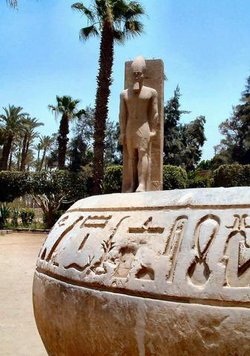Egyptian hieroglyph
|
|
Hieroglyphs are a system of writing used by the Ancient Egyptians, using a combination of logographic, syllabic, and alphabetic elements. The word hieroglyph comes from the Greek words ἱερογλύφος (hierogl?) hiero- (ἱερός), meaning "sacred", and glyph (γλύφειν), meaning "carving".
History and evolution
For many years, the earliest known hieroglyphic inscription was the Narmer Palette, found during excavations at Hierakonpolis (modern Kawm al-Ahmar) in the 1890s, which has been dated to c.3000 BC. However, in 1998 a German archeological team excavating at Abydos (modern Umm el-Qa'ab) uncovered tomb U-j which belonged to a Predynastic ruler, and recovered three hundred clay labels inscribed with proto-hieroglyphics. This grave has been dated to c. 3400 BC.
Hieroglyphs consist of three kinds of characters: phonetic characters, including single-consonant characters, like an alphabet, but also many representing two or three consonants, logographs, representing a word, and determinatives, which indicate the semantic category of a spelled-out word without indicating its precise meaning.
As writing developed and became more widespread among the Egyptian people, simplified letter forms developed, resulting in the hieratic (priestly) and demotic (popular) scripts. These forms were also more suited to use on papyrus. Hieroglyphic writing was not, however, eclipsed, but existed along side the other forms. The Rosetta Stone contains both hieroglyphic and demotic writing.
Hieroglyphs continued to be used under Persian rule (intermittent in the 6th and 5th centuries BC), after Alexander's conquest of Egypt, and during the ensuing Macedonian and Roman periods. It appears that the complexity of late hieroglyphs came about, at least in part, as a response to the changed political situation. Some believe that hieroglyphs functioned as a way to distinguish 'true Egyptians' from the foreign conquerors (and their local lackeys). This aspect may account for misleading quality of surviving comments from Greek and Roman writers about hieroglyphs. Another factor is the pervasive attitude of "respect," coupled with a refusal to tackle a foreign culture on their own terms, which characterized Greco-Roman approaches to Egyptian culture generally. Having learned that hieroglyphs were sacred writing, Greco-Roman authors imagined the complex but rational system as an allegorical, even magical, system transmitting secret, mystical knowledge. This respect engendered not interest, but ignorance.
By the fourth century AD, few Egyptians remained capable of reading hieroglyphs, and the "myth" of hieroglyphs was ascendant. Monumental use of hieroglyphs ceased after the closing of all non-Christian temples in 391 AD by the Roman Emperor Theodosius I; the last known inscription is from a temple far to the south not too long after 391.
Also in the fourth century appeared the Hieroglyphica of Horapollo, an "explanation" of nearly 200 signs. Authoritative yet largely false, the work was a lasting impediment to the decipherment of Egyptian writing. But whereas earlier scholarship emphasized its Greek origin, more recent work has emphasized remnants of genuine knowledge, and cast it as a "desperate" attempt by an Egyptian intellectual to rescue an unrecoverable past. The Hieroglyphica was a major influence on Renaissance symbolism, particularly the emblem book of Andrea Alciato, and including the Hypnerotomachia Poliphili of Francesco Colonna.
Various modern scholars attempted to decipher the glyphs over the centuries, notably Johannes Goropius Becanus in the 16th century and Athanasius Kircher in the 17th century, but such attempts either met with failure or were fictitious decipherments based on nothing but imaginative free-association. The most significant work on deciphering the hieroglyphs was done by Thomas Young and Jean-Fran篩s Champollion beginning the very early 1800s. The discovery of the Rosetta stone by some of Napoleon's troops during the Egyptian invasion provided the critical information which allowed Champollion to make a nearly complete break into hieroglyphs by the 1830s. It was a major triumph for the young discipline of Egyptology.
Hieroglyphs survive today in two forms: directly, through half a dozen Demotic glyphs added to the Greek alphabet when writing Coptic; and indirectly, as the inspiration for the Semitic alphabet that was ancestral to nearly every other alphabet ever used, including our own.
Uniliteral signs
Main article: Egyptian uniliteral signs
The Egyptian hieroglyphic script contained 24 uniliterals (symbols that stood for single consonants, much like English letters). It would have been possible to write all Egyptian words in the manner of these signs, but the Egyptians never did so and never simplified their complex writing into a true alphabet.<ref>Template:Cite book</ref>
Each uniliteral glyph once had a unique reading, but several of these fell together as Old Egyptian developed into Middle Egyptian. For example, the folded-cloth glyph seems to have been originally an /s/ and the door-bolt glyph a /θ/ sound, but these both came to be pronounced as as the sound was lost. A few uniliterals first appear in Middle Egyptian texts.
Besides the uniliteral glyphs, there are also the biliteral and triliteral signs, to represent a specific sequence of two or three consonants in the language.


